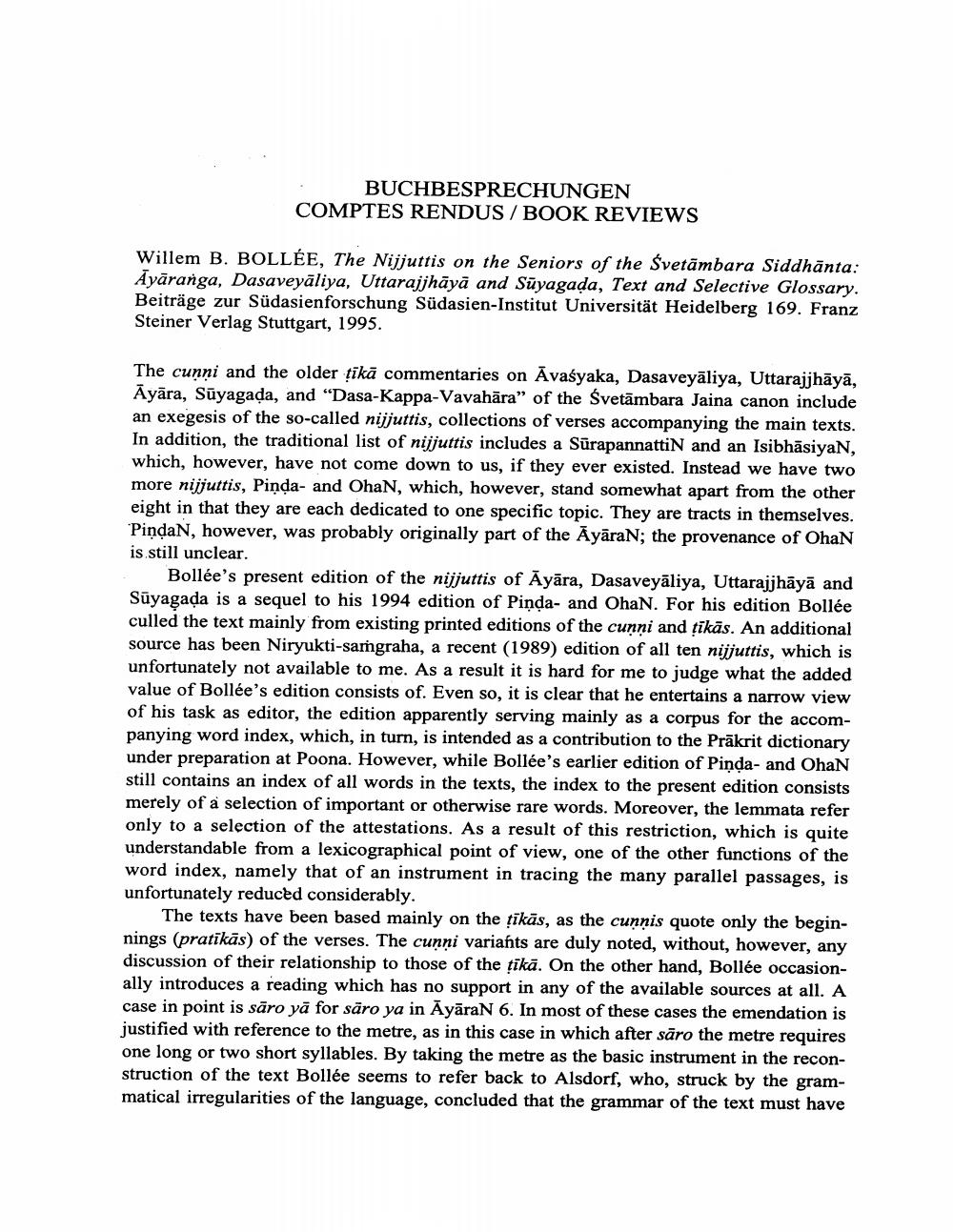Book Title: Buchbesprechungen Comptes Rendus Book Reviews Author(s): W B Bollee Publisher: W B Bollee View full book textPage 1
________________ BUCHBESPRECHUNGEN COMPTES RENDUS/BOOK REVIEWS Willem B. BOLLÉE, The Nijjuttis on the Seniors of the Svetämbara Siddhanta: Ayäranga, Dasaveyāliya, Uttarajjhāyā and Süyagada, Text and Selective Glossary. Beiträge zur Südasienforschung Südasien-Institut Universität Heidelberg 169. Franz Steiner Verlag Stuttgart, 1995. The cunni and the older tika commentaries on Avasyaka, Dasaveyäliya, Uttarajjhāyā, Ayāra, Süyagada, and "Dasa-Kappa-Vavahära" of the Svetambara Jaina canon include an exegesis of the so-called nijjuttis, collections of verses accompanying the main texts. In addition, the traditional list of nijjuttis includes a SürapannattiN and an IsibhāsiyaN, which, however, have not come down to us, if they ever existed. Instead we have two more nijjuttis, Pinda- and OhaN, which, however, stand somewhat apart from the other eight in that they are each dedicated to one specific topic. They are tracts in themselves. PindaN, however, was probably originally part of the AyäraN; the provenance of OhaN is still unclear. Bollée's present edition of the nijjuttis of Äyāra, Dasaveyäliya, Uttarajjhāyā and Sūyagada is a sequel to his 1994 edition of Pinda- and OhaN. For his edition Bollée culled the text mainly from existing printed editions of the cunni and tīkās. An additional source has been Niryukti-samgraha, a recent (1989) edition of all ten nijjuttis, which is unfortunately not available to me. As a result it is hard for me to judge what the added value of Bollée's edition consists of. Even so, it is clear that he entertains a narrow view of his task as editor, the edition apparently serving mainly as a corpus for the accompanying word index, which, in turn, is intended as a contribution to the Prakrit dictionary under preparation at Poona. However, while Bollée's earlier edition of Pinda- and OhaN still contains an index of all words in the texts, the index to the present edition consists merely of a selection of important or otherwise rare words. Moreover, the lemmata refer only to a selection of the attestations. As a result of this restriction, which is quite understandable from a lexicographical point of view, one of the other functions of the word index, namely that of an instrument in tracing the many parallel passages, is unfortunately reduced considerably. The texts have been based mainly on the tīkās, as the cunnis quote only the beginnings (pratikās) of the verses. The cunni variants are duly noted, without, however, any discussion of their relationship to those of the ṭīkā. On the other hand, Bollée occasionally introduces a reading which has no support in any of the available sources at all. A case in point is saro ya for saro ya in AyaraN 6. In most of these cases the emendation is justified with reference to the metre, as in this case in which after säro the metre requires one long or two short syllables. By taking the metre as the basic instrument in the reconstruction of the text Bollée seems to refer back to Alsdorf, who, struck by the grammatical irregularities of the language, concluded that the grammar of the text must havePage Navigation
1 2 3 4
